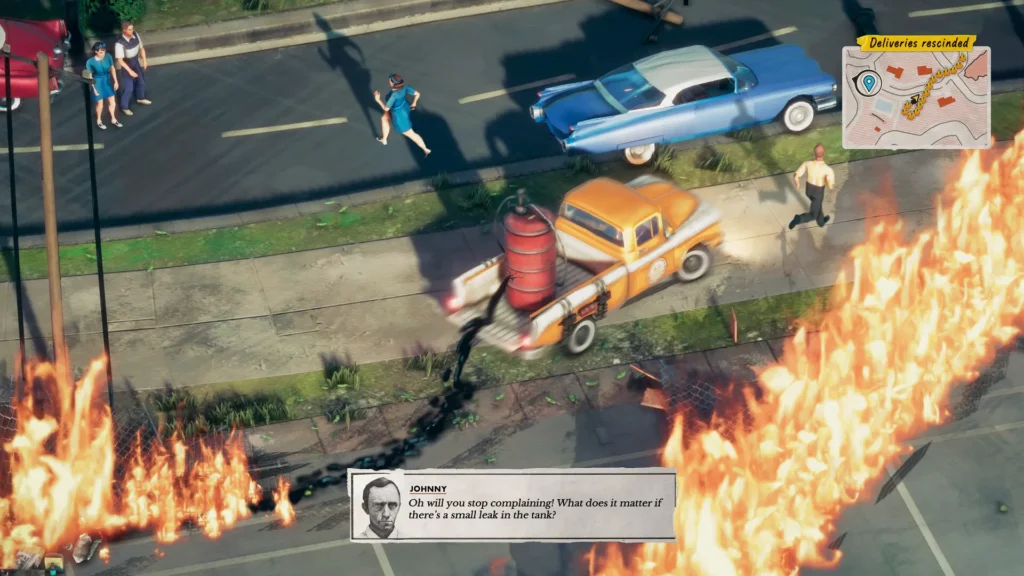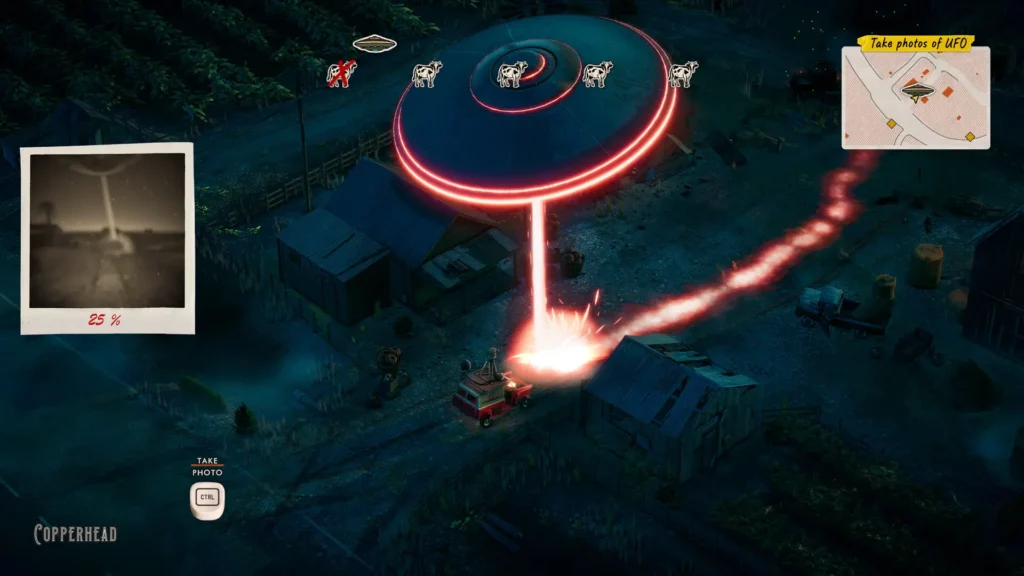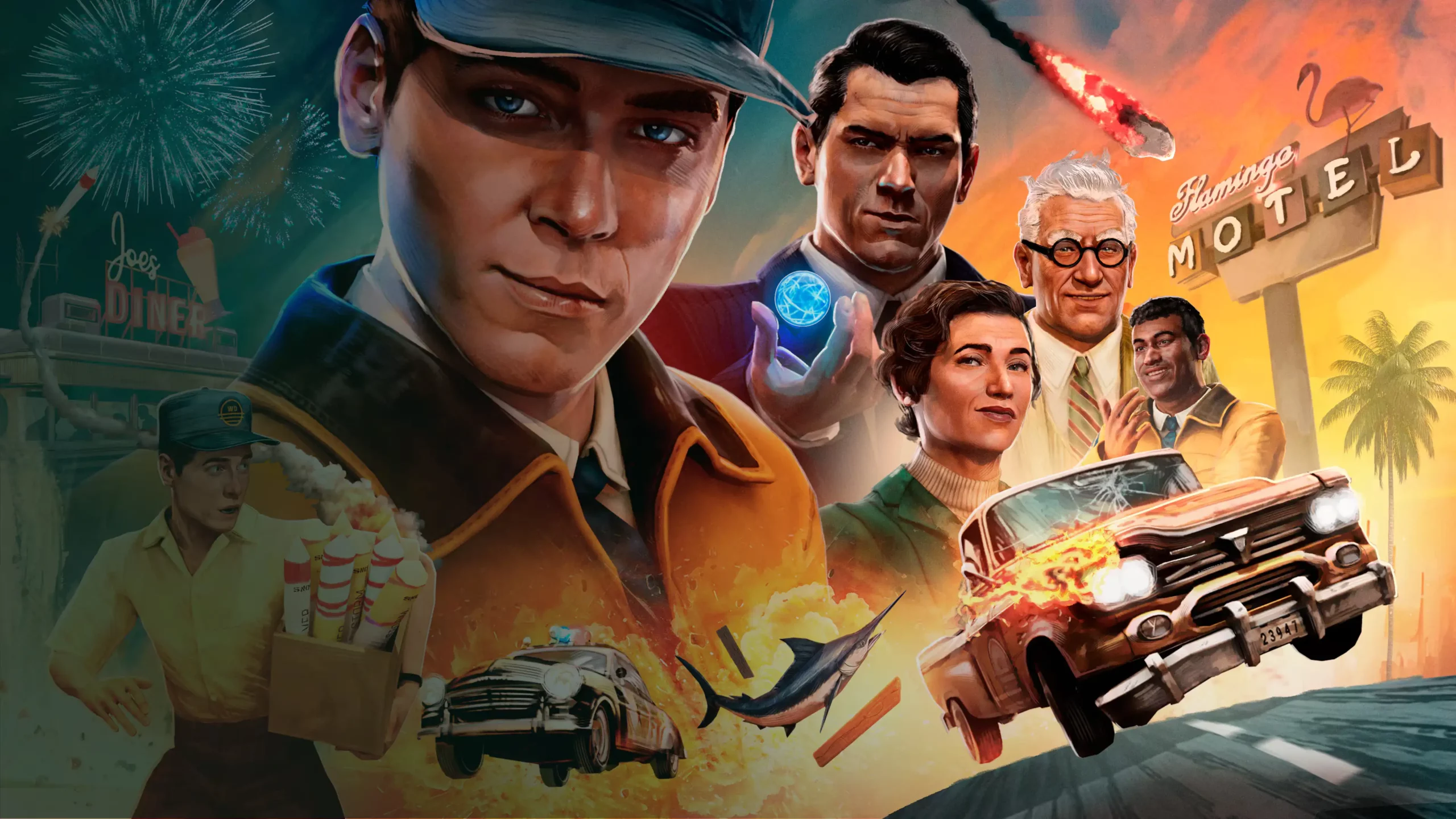Deliver At All Costs isn’t your typical delivery simulator. Instead of meticulously balancing cargo or carefully navigating treacherous terrain, this game throws players into a chaotic, destructible world set in a vibrant 1950s small-town America. Behind the wheel of a delivery truck, players take on the role of Winston Green, a fresh recruit at the We Deliver corporation, tasked with hauling increasingly bizarre cargo through a landscape where almost everything—road signs, fences, shopfronts, and even pedestrians—can be smashed to pieces. The result is a high-octane, destruction-fueled experience that feels more like a demolition derby than a standard courier job. Priced at $29.99, the game offers a roughly 10-hour campaign that’s initially thrilling but struggles to maintain its momentum due to a shaky Hawkinski, repetitive missions, and a lackluster narrative arc.
A World Built to Be Broken
The standout feature of Deliver At All Costs is its jaw-dropping destructibility. Viewed from one of two top-down camera angles, the game’s open-world environment is a playground of chaos where nearly everything above ground can be reduced to rubble. Apartment buildings collapse like Jenga towers, tennis courts crumble, and graveyards become fields of shattered tombstones as players plow through in their delivery truck. The three-city map is rich with 1950s charm, from Christmas lights adorning main streets to a drive-in theater screening black-and-white films. However, the destruction often feels too easy—structures collapse as if made of cards rather than bricks, with little impact or loss of momentum. This weightless feel doesn’t detract from the initial joy of carving shortcuts through hotel lobbies or parks, but abrupt loading screens between city districts disrupt the flow, and the world proves more rewarding to demolish than to explore in depth.
Winston’s Wild Ride
Players step into the shoes of Winston Green, a likable rookie driver with a mysterious past. He’s on the run from an unspecified incident, and the game hints at a deeper backstory that never fully materializes. The narrative begins as a lighthearted workplace comedy, filled with quirky characters and absurd delivery tasks. However, it soon takes jarring turns into corporate conspiracies and outlandish time-travel plotlines. Winston’s journey feels like assembling a piece of flat-packed furniture—full of intriguing components that, once put together, reveal a structure that’s shakier than expected. The fast-tracked climax leaves players feeling unfulfilled, as if they’ve tried to make a meal out of packing peanuts. The story’s tonal shifts and loose ends fail to deliver a satisfying resolution, undermining the game’s otherwise chaotic charm.
Missions That Swing Between Genius and Generic
The game’s 20 main missions center on delivering increasingly odd cargo, each with a unique twist that keeps players on their toes—or at least tries to. Some tasks are undeniably creative. In one, players transport a bundle of helium balloons, where every bump sends the truck floating clumsily, forcing a delicate balance to stay grounded. Another mission involves towing a leaking napalm tank, creating a fiery trail that turns the delivery into a citywide game of Snake, where doubling back risks an explosive end. A particularly memorable job has players dragging a mayor’s statue to the town square while dodging seagulls dropping their own “special deliveries.” These moments are laugh-out-loud highlights, showcasing the game’s ability to blend absurdity with engaging gameplay.
However, not every mission hits the mark. Some feel repetitive or uninspired. For example, a task to drive recklessly to scare a limousine full of corrupt executives doesn’t stand out when reckless driving is the default in every other mission. Another, involving photographing cows being abducted by a UFO, boils down to mindlessly spamming the camera button, stripping away any sense of challenge. A mission to retrieve a stolen truck from a scrapyard under a security van’s watch promises tension but falls flat due to a nonexistent stealth system—players can simply walk in unopposed, requiring minimal effort or strategy. On-foot sections, which involve basic walking, jumping, climbing, and shoving, feel like dull interludes compared to the vehicular chaos that defines the game’s best moments.

A Forgiving World with Little Consequence
Deliver At All Costs leans heavily into its carefree chaos, but its leniency often undercuts the excitement. Flip the truck? It rights itself automatically. Blow a tire? A quick button tap repairs it instantly. Collapse an entire building by doing doughnuts through its foundation? The police might give chase, but their presence is fleeting—explained away by a narrative tidbit about their near-nonexistence in this island town. Escaping them is as simple as hopping out of the truck and diving into a dumpster, no line-of-sight required. Even if caught, players respawn immediately with no real penalty. This lack of consequences gives players the freedom to drive like maniacs, but it also makes the stakes feel frustratingly low.
This forgiving nature is most evident in missions that should be pulse-pounding. Delivering an armed atom bomb, for instance, ought to feel like flirting with catastrophe. Instead, there’s no ticking clock to force urgency, allowing players to creep along at a leisurely pace. The only challenge is to not drive like a lunatic—a stark contrast to the game’s usual encouragement of chaos. Even when a collision triggers an explosion, generous checkpoints ensure players are back on the road with minimal loss of progress. While nobody wants a game to be punishingly difficult, Deliver At All Costs swings too far in the opposite direction, draining tension from moments that should be exhilarating.
A Detailed but Empty Sandbox
The game’s world is a visual treat, brimming with 1950s Americana. Main streets lined with Christmas trees, retro diners, and a giant drive-in theater create a nostalgic atmosphere. Yet, beyond the main campaign, there’s little to do when off the clock. Ten side missions are scattered across the map, but most are forgettable. A basic circuit race and a couple of missing-person searches lack the creativity of the best main missions. One exception stands out: a side task involving a satanic sports car that feels ripped from a horror novel, offering a brief but thrilling detour. Unfortunately, such moments are rare, and the world feels underutilized as a result.

Vehicles and Upgrades That Underwhelm
The game includes unique vehicles like an ambulance and an ice cream van, but they disappoint on multiple fronts. Their locations are marked on the map from the outset, removing any sense of discovery akin to finding a hidden gem in other open-world games. There’s no garage to store them, and they can’t be used for delivery missions, relegating them to brief joyrides before players return to the standard We Deliver truck. Worst of all, these vehicles handle nearly identically to the default truck, offering no meaningful variety. There are no unique missions tied to them—no emergency runs in the ambulance or dessert drops in the ice cream van—making their inclusion feel like an afterthought.
Upgrades for the delivery truck, earned through spare parts found in the world (sometimes absurdly, like finding a single roll of duct tape in a giant chest), also fail to live up to their potential. A crane is useful for a mission involving loading a giant marlin onto the truck, leading to a fishtailing drive to the drop-off point. A winch and a supercharged horn that shatters shopfront windows add some flair, but these upgrades are restricted to specific story missions. Outside of those moments, players can’t use the winch to drag random objects or pedestrians for fun, nor can they deploy the cargo bed catapult freely. These limitations stifle the creative mayhem that a game so eager to be knocked down should embrace, falling short of the freeform chaos seen in titles like Goat Simulator.
A Narrative That Crumbles Under Scrutiny
The story of Winston Green starts with promise. He’s a relatable everyman, new to the job and running from a shadowy past. The early tone is playful, leaning into the absurdity of delivering bizarre cargo in a destructible world. But as the plot unfolds, it veers into corporate crime conspiracies and a preposterous time-travel arc that feels out of place. The narrative introduces intriguing elements but fails to weave them into a cohesive whole. By the time the rushed climax arrives, it feels hollow, leaving players with more questions than answers. It’s like opening a promising package only to find it’s missing key pieces, resulting in a disappointing finish that undermines the game’s chaotic energy.

Balancing Chaos and Missed Opportunities
At its best, Deliver At All Costs is a riotous romp through a destructible 1950s sandbox. The ability to smash through nearly anything in the delivery truck is a thrill, and the most creative missions—like dodging seagull attacks or wrestling with a balloon-lifted truck—deliver genuine laughs and excitement. The world is packed with nostalgic detail, from retro theaters to festive streets, creating an inviting backdrop for chaos. Yet, the game stumbles in critical areas. The story’s tonal shifts and unsatisfying conclusion fail to capitalize on its early promise. Many missions feel repetitive or lack intensity, and the overly forgiving mechanics sap tension from high-stakes moments. Side content is sparse and uninspired, unique vehicles are underutilized, and upgrades are too restricted to unlock the full potential of the game’s destructive playground.
Final Thoughts on the Delivery Run
Deliver At All Costs bursts onto the scene with a destructive flair that’s hard to resist. For every brilliantly absurd mission, there’s another that feels flat or overly simplistic. The world is a visual delight but lacks meaningful activities to keep players engaged beyond the main campaign. Upgrades and unique vehicles tease possibilities for deeper chaos but are held back by restrictive design. The narrative, while initially engaging, crashes into a disappointing finale. At $29.99, Deliver At All Costs offers a wild ride worth taking for its chaotic highs, but it falls short of being the complete package, leaving players wanting more from its fragile, fascinating world.
